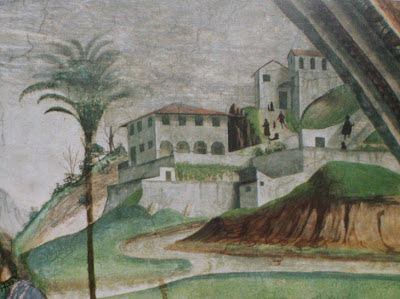"It's one of the most dramatic stories in 15th century Florence. In 1478, the Pazzi, a well-established Florentine banking family, with support from Pope Sixtus IV, the King of Naples, and the Archbishop of Pisa, and others, hatched a plot so daring as to almost appear ridiculous: to kill Giuliano and Lorenzo de' Medici in order to take control of Florence. On Sunday, April 26, during High Mass in the Duomo, assassins, armed with knives, attacked the two brothers. Francesco de' Pazzzi and Bernardo Bandini Baroncelli stabbed Giuliano nineteen times, killing him. Two armed priests went for Lorenzo, but Lorenzo fled with only a wound and locked himself in the north sacristy." (from Florence Sights and Landmarks, by Cheryl Tucker.
The Pazzi coat of arms is pictured above. I haven't been able to find any information about the significance of what appears to be two dolphins. I'll be looking for clues in Medieval History, as the Pazzi (means "crazy men"?) were an old family who allegedly participated in the First Crusade.
Why Florence? And, "Why Florence again and again?" people ask me. This blog will attempt to explore that question. Along the way I hope to share how I stay connected to my adopted city when I'm not there. Ideally, I would be in Tuscany every spring, every fall.
Friday, September 28, 2012
Sunday, September 23, 2012
This Handsome Young Man . . .
At the time of his death, Giuliano was no longer enamored of Simonetta Vespucci, as she herself had died exactly two years earlier, on April 26, 1476. Giuliano had taken as his lover Fioretta Gorini, the daughter of a tradesman. Fortunately for the Medici family, Giuliano had taken some of his friends into his confidence, and after his death, it was revealed to Lorenzo that Giuliano had had a love affair which was to result in the birth of a boy on May 26, 1478. Lorenzo reportedly sought out Fioretta, and "without much difficulty, persuaded her to let him have the rearing of the child." (per David Loth, in Lorenzo the Magnificent)
The child was named Giulio, and was raised along side the other children of Lorenzo and Clarice. Giulio was later to become Pope Clement VII.
Tuesday, September 18, 2012
Is this Simonetta Vespucci?
This detail is one of the "three graces" in Botticelli's "Primavera," which hangs in the Uffizi in Florence. But who is she? And is she the same model, or inspiration, for the central figure in Botticelli's "Birth of Venus," which also hangs in the Uffizi?
For centuries, people have speculated on this matter. A pretty story is that she is Simonetta Cattaneo de Candia Vespucci (1453-1476), a young noblewoman, perhaps from Liguria, who married a distant cousin of Amerigo Vespucci when she was 15 or 16. She met Marco, her husband-to-be, in Genoa, but they were married at the Medici Palazzo in Florence because of Marco's connections to the Medici family.
Soon all of Florence was in love with Simonetta. She was feted at a Joust held in Piazza Santa Croce in 1475, where Lorenzo's brother, Giuliano, carried a banner painted by Botticelli on which was created a likeness of her.
Unfortunately, she died the very next year. Her image continued to be recreated by Botticelli for many years to come. And he asked to be buried at her feet in the Church of Ognissanti when he died some 34 years later.
Sunday, September 16, 2012
More on the Medici Villas
Here, in a drawing by an unknown artist, is the Medici Villa in Fiesole, the hilltown above Firenze. This hilltop dwelling, commissioned by Giovanni, Cosimo il Vecchio's second son, with its view over the city, is the very first example of a Renaissance villa: that is to say it follows the Albertian criteria for rendering a country dwelling a "villa suburbana". Once believed to have been designed by the architect Michelozzo, current attribution is given to Alberti.
Unlike the other Medici in the countryside, which are the centers of agricultural operations, this villa has around it only a very beautiful garden. Visitors to the garden are allowed, in groups, with advance reservations by fax: (+39) 055 2398994.
This villa, and 13 other Medici villas, has been nominated for inclusion in the list of UNESCO World Heritage Sites. More information, and a way to sign the petition is here:
http://www.turismo.intoscana.it/intoscana2/export/TurismoRTen/sito-TurismoRTen/Contenuti/Elementi-interesse/Siti-storici/visualizza_asset.html_334468815.html
Tuesday, September 11, 2012
Clarice, lonely for Lorenzo, writes . . .
From Clarice de' Medici to her husband Lorenzo at Florence (from Lives of the early Medici as told in their letters):
"By the bearer we send you seventeen partridges which your falconers took to-day. I should have been glad had you come to enjoy them with us; we have expected you until the third hour (an hour before sunset) for the last three evenings. I was astonished you did not come and fear something extra-orrdinary must have happened to keep you. I beg that if it is so you will let me know, for surely it is in any case better we should be together than one in France and the other in Lombardy. I expect you at all events to-morrow and pray if it is possible that we should not await you in vain. The children are well and so are all of the rest of the family. I commend myself to you, and beg you to come and to bring Madonna Lucrezia." Cafaggiuolo, August 20, 1476
Subscribe to:
Posts (Atom)




